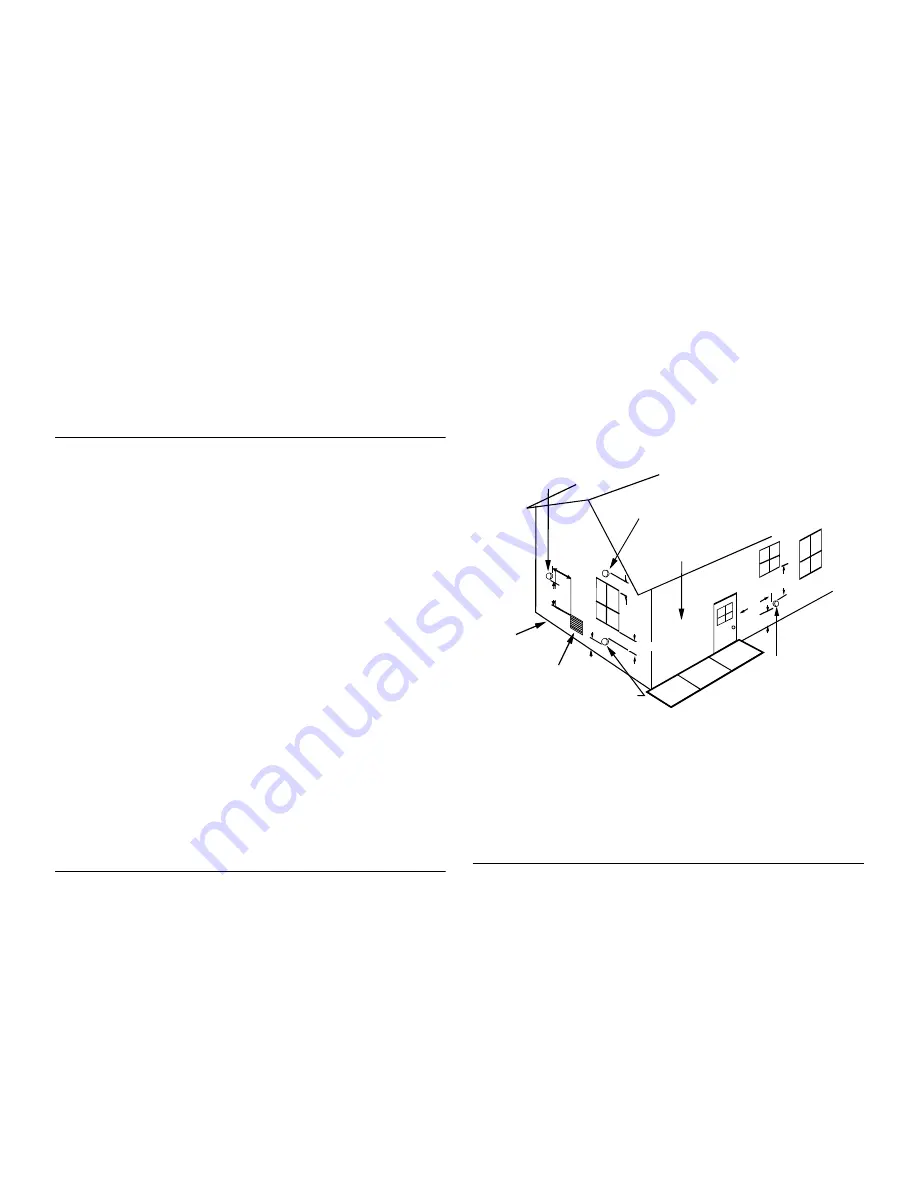
14
Carefully follow
¹⁄₂
" (1.3 cm) thick closed-cell foam. Also all vent/
flue piping exposed outdoors in excess of the terminations
shown in this manual (or in unheated areas) must be insulated
with
¹⁄₂
" (1.3 cm) thinck closed_ the manufactures instructions for
cutting, cleaning and solvent cementing of PVC.
As an alternative to PVC pipe, primer, solvent cement and fittings,
ABS materials which are in compliance with the following
specifications may be used. 2" or 3" (5.1 cm or 7.6 cm) ABS
Schedule 40 pipe must meet ASTM D1527 and, if used in
Canada, must be CSA listed. Solvent cement for ABS to ABS
joints must meet ASTM D2235 and, if used in Canada, must be
CSA listed.
The solvent cement for the PVC to ABS transition joint must meet
ASTM D3138.
Fittings must be DWV type fittings meeting ASTM D2661 and
ASTM D3311 and, if used in Canada, must be CSA listed.
Carefully follow the manufacturers’ instructions for cutting,
cleaning, and solvent cementing PVC and/or ABS.
All 90° elbows must be medium radius (
¹⁄₄
bend DWV) or long
radius (long sweep
¹⁄₄
bend DWV) types conforming to ASTM
D3311. A medium radius (
¹⁄₄
bend DWV) elbow measures 3
¹⁄₁₆
"
(7.8 cm) minimum from the plane of one opening to the centerline
of the other opening for 2" (5.1 cm) diameter pipe, and 4
⁹⁄₁₆
"
(11.6 cm) minimum for 3" (7.6 cm) pipe.
Proper Vent/Flue and Combustion Air Piping
Practices
Adhere to these instructions to ensure safe and proper furnace
performance. The length, diameter and number of elbows of the
vent/flue pipe and combustion air pipe (when applicable) affects
the performance of the furnace and must be carefully sized. All
piping must be installed in accordance with local codes and
these instructions.
Piping must be adequately secured and supported to prohibit
sagging, joint separation and/or detachment from the furnace.
Horizontal runs of vent/flue piping must be supported every 3 ft
to 5 ft (91.4 cm to 1.5 m) and must maintain a
¹⁄₄
" (6.4 mm) per
foot downward slope, back toward the furnace, to properly return
condensate to the furnace’s drain system. Allowances should be
made for minor expansion and contraction due to temperature
variations. For this reason, particular care must be taken to
secure piping when a long run is followed by a short offset of less
than 40" (101.6 cm).
Precautions should be taken to prevent condensate from freezing
inside the vent/flue pipe and/or at the vent/flue pipe termination.
All vent/flue piping exposed to freezing temperatures below 35ºF
(2ºC) for extended periods of time must be insulated with
¹⁄₂
"
(1.3 cm) thick closed-cell foam. Also, all vent/flue piping exposed
outdoors in excess of the terminations shown in this manual (or in
unheated areas) must be insulated with
¹⁄₂
" (1.3 cm) thick closed-
cell foam. Inspect piping for leaks prior to installing insulation.
Termination Locations
NOTE: Refer to “Location Requirements and Considerations” for
combustion air contaminant restrictions.
The following bullets and illustration describe the restrictions
concerning the appropriate location of vent/flue pipe and
combustion air intake pipe (when applicable) terminations. Refer
to “Nondirect Vent (Single Pipe) Piping” and “Direct Vent (Dual
Pipe) Piping” located in this section for specific details on
termination construction.
■
All terminations (flue and/or intake) must be located at least
12" (30.5 cm) above ground level or the anticipated snow
level.
■
Vent terminations (nondirect and direct vent) must terminate
at least 3 ft (91.4 cm) above any forced air inlet located within
10 ft (3 m).
NOTE: This provision does not apply to the combustion air
intake termination of a direct vent application.
■
The vent termination of a nondirect vent application must
terminate at least 4 ft (121.9 cm) below, 4 ft (121.9 cm)
horizontally from or 12" (30.5 cm) above any door, window or
gravity air inlet into any building.
■
The vent termination of a direct vent application must
terminate at least 12" (30.5 cm) from any opening through
which flue gases may enter a building (door, window or
gravity air inlet).
■
The vent termination of vent pipe run vertically through a roof
must terminate at least 12" (30.5 cm) above the roof line (or
the anticipated snow level) and be at least 12" (30.5 cm) from
any vertical wall (including any anticipated snow buildup).
■
A vent termination shall not terminate over public walkways
or over an area where condensate or vapor could create a
nuisance or hazard or could be detrimental to the operation
of regulators, relief valves or other equipment.
■
The combustion air intake termination of a direct vent
application should not terminate in an area which is
frequently dusty or dirty.
Vent Termination Clearances
NOTE: In Canada, the Canadian Fuel Gas Code takes
precedence over the preceding termination restrictions.
Canadian Venting Requirements
In Canada, venting must conform to the requirements of the
current CAN/CSA-B149.1-05 Installation Code. Use only CSA-
listed, ULC-S636 compliant 2" or 3" (5.1 cm or 7.6 cm) diameter
PVC or ABS pipe, solvent cement and fittings throughout. The
certified piping should be clearly marked with the ULC Std
“S636” on the pipe and fittings.
Carefully follow the pipe manufacturers’ instructions for cutting,
cleaning and solvent cementing PVC and/or ABS.
The vent can be run through an existing unused chimney
provided the space between the vent pipe and the chimney is
insulated and closed with a weather-tight, corrosion-resistant
flashing.
A. Nondirect vent and direct vent
vent/flue terminations
B. Nondirect vent—vent/flue
terminations
C. No terminations above walkway
D. 4" (10.2 cm) minimum)
E. 12" (30.5 cm) minimum
F. Direct vent—vent/flue
termination
G. Forced air inlet
H. Grade or highest anticipated
snow level
I. 3" (7.6 cm) minimum
J. Less than 10 ft (3 m)
A
B
C
D
D
E
E
E
E
B
J
F
G
H
I















































